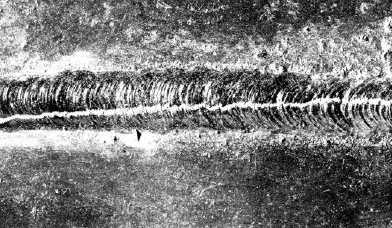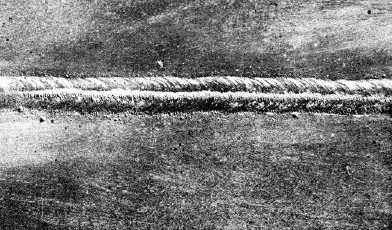T.O. 33B-1-1
3-92
Figure 3-42. Sharp, Well Defined Indication of Surface Discontinuity in a Weld
Figure 3-43. Broad Indication of Subsurface Discontinuity in a Weld
3.7.3.3
Evaluating The Indication
Finally, after the indication has been formed and has been interpreted, it must be evaluated. Evaluation is the
determination of the consequences of the presence of the discontinuity. This includes determining if the discontinuity
is a defect and if so, can the part be reworked or repaired, or must the part be scrapped.
3.7.3.3.1
Generally, an inspector has fairly detailed guidance concerning the interpretation and evaluation of indications
included with the procedure by which the inspection was done. In the event such guidance is not available, the
following basic considerations may be used in conjunction with the inspector's knowledge and experience to help in the
evaluation of indications.
a. A discontinuity of any kind lying at the surface is more likely to be harmful than a discontinuity of the
same size and shape which lies below the surface.
b. Any discontinuity having a principal dimension or a principal plane which lies at right angles or at a
considerable angle to the direction of principal stress, whether the discontinuity is surface or sub-
surface, is more likely to be harmful than a discontinuity of the same size, location, and shape lying
parallel to the stress.



